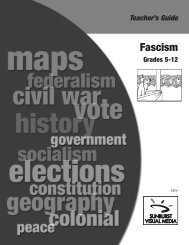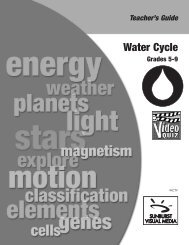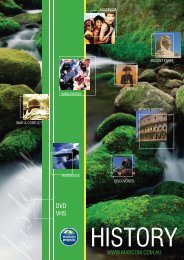Thrilling Experiments: Potential and Kinetic Energy
Thrilling Experiments: Potential and Kinetic Energy
Thrilling Experiments: Potential and Kinetic Energy
Create successful ePaper yourself
Turn your PDF publications into a flip-book with our unique Google optimized e-Paper software.
Extensions<br />
• Soda Towers<br />
Have students create soda can towers by stacking empty soda cans in a variety<br />
of different ways. Use different variations <strong>and</strong> different numbers of cans to create<br />
several towers. Crash the towers by rolling a single empty can into them. Students<br />
should observe the cans as they fall <strong>and</strong> note how far they roll. Have them add up<br />
the number of inches they roll <strong>and</strong> graph their findings.<br />
Additional<br />
Resources<br />
• Physical Science<br />
Students can calculate the work done <strong>and</strong> energy consumed over an entire work out.<br />
Track <strong>and</strong> field, skiing, gymnastics, <strong>and</strong> professional wrestling provide great examples<br />
of the use of work <strong>and</strong> energy transformations.<br />
• Marbles in Motion<br />
Gather marbles or other small balls of various mass, ruler or other guide<br />
track, lined paper <strong>and</strong> tape, stopwatch. Make a V-shaped catcher from cardboard, a<br />
5x8-index card, etc. Tape the lined paper <strong>and</strong> the ruler down<br />
to a flat surface. Mark the starting point for the catcher, making sure it is exactly in<br />
line with the ball the marbles take. Flick the marble along the track <strong>and</strong> time how<br />
long it takes from when it leaves the track until it hits the catcher. Precise timing is<br />
tricky. It will take practice. The longer the distance from the ruler to<br />
the catcher the longer the time is <strong>and</strong> the easier to time accurately, but the more the<br />
marble will slow down due to friction. If no stopwatch is available, rough qualitative<br />
comparisons can still be made. Measure the distance from the end<br />
of the track to the catcher v=d/t. Note how far the catcher is dragged by the marble.<br />
Note the effect of varying speeds <strong>and</strong> masses. Do the same experiment on a larger<br />
scale with larger balls rolled across the floor into a larger catcher made rom a<br />
cardboard box. Try different designs for the catcher. Use baseballs, tennis balls,<br />
softballs etc. The balls can be rolled without a track to guide them as care is taken to<br />
hit the catcher in the center. Again note the effects of mass <strong>and</strong> velocity. The faster a<br />
car is going, the longer the distance required to stop.<br />
• Tug-O-War Science<br />
Head outside to the playground for a tug of war! Use different size groups of students<br />
on each side. Record the number of minutes it takes to win when the students on the<br />
winning side are short, tall, heavy, etc. Have additional contests with the students<br />
st<strong>and</strong>ing on various surfaces (grass vs. pavement for example) <strong>and</strong> discuss whether<br />
one team has an advantage or not. Have students record <strong>and</strong> graph the results from<br />
the contests for comparison.<br />
26<br />
<strong>Thrilling</strong> <strong>Experiments</strong>: <strong>Potential</strong> <strong>and</strong> <strong>Kinetic</strong> <strong>Energy</strong> © Sunburst Visual Media, a division of Global Video, LLC











